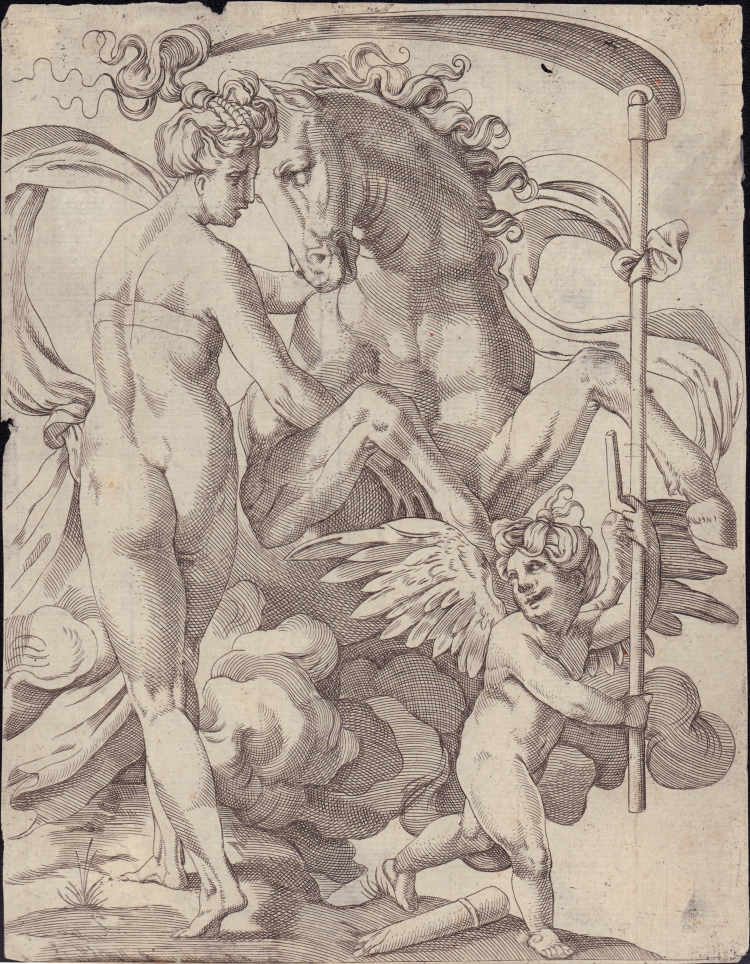




| Reference: | S38115 |
| Author | Pierre MILAN |
| Year: | 1550 ca. |
| Measures: | 135 x 175 mm |



| Reference: | S38115 |
| Author | Pierre MILAN |
| Year: | 1550 ca. |
| Measures: | 135 x 175 mm |
Engraving, 1550 circa. After Caraglio.
Good example, printed on contemporary laid paper with “p-gothic” watermark, trimmed at margins, without the number and the verses under the image, some scratched.
This is a copy in the same direction of Caraglio's print.
It belongs to the set of copies identified by James Grantham Turner as by Pierre Milan or René Boyvin (see Print Quarterly XXVII 2010, pp.231-52), realized around 1550. There is a document dated 29 march 1550 in which “Pierre de Myllan” sells to the dealer Claude Bernard for 50 escuz soleil “deux cens cinquante livres de figures imprimées de lames de cuivre appellez vulgairement Les Amours de dieux contenant chacun livre XX figures”
Vasari records that the series (like the 'Gods in Niches') was begun as a collaboration between Caraglio and Rosso; after Rosso's departure the set of 20 was finished by Perino del Vaga.
|
James Grantham Turner in 'Print Quarterly' XXVII 2010, pp.231-52.
|
|
French medallist and engraver. He is first recorded in 1545 and was working as an assistant to the medallist Marc Béchot in 1547. His prints are unsigned and were for a long time attributed to RENÉ BOYVIN, who was his pupil in 1549–50. He has been identified with the copper-plate engraver Pierre de La Cuffle, who is mentioned by Karel van Mander I. He was often in debt and was several times obliged to pledge his plates to his creditors, who included François Clouet. He remained in close contact with Boyvin, who in 1553 finished two plates begun by Milan. They worked together on the inventory drawn up on the death of Luca Penni in 1557. Zerner attributed seven engravings to him, including Dance of the Dryads after Rosso Fiorentino, Jupiter and Callisto after Francesco Primaticcio and Clelia Escaping from the Camp of Porsena after Giulio Romano. Perhaps the most interesting of the works attributed to him is the print of the Nymph of Fontainebleau, the only part of the decorative ensemble of the Galerie François I at the château of Fontainebleau to be engraved by the Parisian printmakers of the time. It contributed to the spread of the theme of Diana in French 16th-century engraving. It seems likely that some engravings attributed to Boyvin are by Milan.
|
|
James Grantham Turner in 'Print Quarterly' XXVII 2010, pp.231-52.
|
|
French medallist and engraver. He is first recorded in 1545 and was working as an assistant to the medallist Marc Béchot in 1547. His prints are unsigned and were for a long time attributed to RENÉ BOYVIN, who was his pupil in 1549–50. He has been identified with the copper-plate engraver Pierre de La Cuffle, who is mentioned by Karel van Mander I. He was often in debt and was several times obliged to pledge his plates to his creditors, who included François Clouet. He remained in close contact with Boyvin, who in 1553 finished two plates begun by Milan. They worked together on the inventory drawn up on the death of Luca Penni in 1557. Zerner attributed seven engravings to him, including Dance of the Dryads after Rosso Fiorentino, Jupiter and Callisto after Francesco Primaticcio and Clelia Escaping from the Camp of Porsena after Giulio Romano. Perhaps the most interesting of the works attributed to him is the print of the Nymph of Fontainebleau, the only part of the decorative ensemble of the Galerie François I at the château of Fontainebleau to be engraved by the Parisian printmakers of the time. It contributed to the spread of the theme of Diana in French 16th-century engraving. It seems likely that some engravings attributed to Boyvin are by Milan.
|